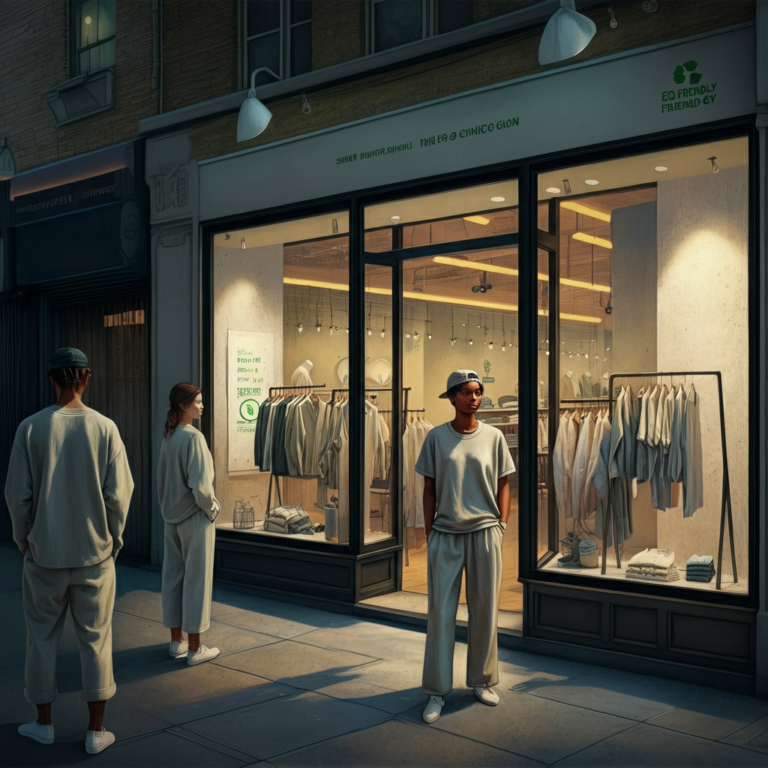The Japanese retailer Uniqlo has become a global phenomenon, offering affordable basics and innovative fabrics to millions of consumers worldwide. But as sustainability concerns grow, many shoppers ask: Is Uniqlo fast fashion? The answer isn’t straightforward. While Uniqlo’s CEO, Tadashi Yanai, explicitly stated that the brand is not fast fashion, it operates in a complex grey area that combines elements of both traditional retail and modern mass production.
This comprehensive analysis examines Uniqlo’s business model, sustainability practices, and its position within the broader fashion industry, enabling you to understand where this popular retailer truly stands.
Table of Contents
What Defines Fast Fashion?
Fast fashion represents a business model characterized by speed, affordability, and the replication of trends. The industry thrives on rapid production cycles that can transform runway trends into retail-ready garments within weeks.
Key Characteristics of Fast Fashion
Rapid Production and Trend Replication
Traditional fast fashion brands monitor runway shows and street style trends, then quickly produce similar designs at accessible price points. This process typically takes 2-4 weeks from concept to store shelves.
Low Prices and Disposability
Fast fashion prioritizes affordability over durability. Garments are designed to be worn frequently for short periods before being replaced with newer styles.
High Volume Production
These companies produce massive quantities of clothing to meet global demand and maintain low per-unit costs.
Frequent Collection Releases
Instead of traditional seasonal collections, fast fashion brands release new items on a weekly or bi-weekly basis to keep customers engaged and encourage regular purchasing.
Environmental and Ethical Concerns
The fast fashion industry faces significant criticism for its environmental impact and labor practices. The sector accounts for approximately 10% of global carbon emissions and generates substantial textile waste. Additionally, the pressure to maintain low costs often leads to poor working conditions and unfair wages in manufacturing facilities.
Where Uniqlo Differs from Traditional Fast Fashion
Uniqlo’s approach to retail sets it apart from conventional fast fashion brands in several key ways.
Emphasis on Quality and Durability
Unlike typical fast fashion retailers, Uniqlo invests heavily in fabric technology and construction quality. The brand’s research and development team works to create materials that maintain their shape, color, and comfort after repeated washing and wearing.
Their Heattech thermal wear line, for example, uses advanced synthetic fibers that provide warmth while remaining lightweight and breathable. This focus on functional innovation distinguishes Uniqlo from brands that prioritize aesthetics over performance.
Focus on Basic, Timeless Designs
Uniqlo’s core philosophy is to create essential wardrobe pieces rather than trend-driven items. Their product line consists primarily of basics, including plain t-shirts, jeans, sweaters, and outerwear, all in neutral colors.
This approach aligns with their “Lifewear” concept, which positions their clothing as everyday essentials designed for long-term use rather than seasonal disposal.
Innovative Materials and Technology
The brand consistently develops proprietary fabrics and technologies, including:
- Heattech for thermal regulation
- Airism for moisture-wicking properties
- Ultra Light Down for packable insulation
- Dry-EX for athletic performance
These innovations require significant research and development investment, contrasting with the fast fashion model of quickly copying existing designs.
Aspects of Uniqlo That Resemble Fast Fashion
Despite its differences, Uniqlo shares specific characteristics with the fast fashion industry, which complicates its classification.
High-Volume Production
Uniqlo operates on a massive scale, producing millions of garments annually across its global manufacturing facilities. This volume of production raises environmental concerns regardless of the brand’s focus on quality and durability.
Affordability and Accessibility
The brand’s pricing strategy makes fashion accessible to a broad consumer base, like fast fashion retailers. Basic t-shirts, jeans, and other essentials are priced competitively with traditional fast fashion brands.
Incorporation of Contemporary Styles
While Uniqlo doesn’t directly copy runway trends, the brand adapts contemporary styles and seasonal colors into its collections. Their collaboration with designers and artists also introduces trend-conscious elements to their otherwise basic offerings.
“Diet” Fast Fashion Approach
Some industry analysts describe Uniqlo as practicing “diet” fast fashion—a more measured approach to trend-driven production that maintains some characteristics of the fast fashion model while emphasizing quality and longevity.
Uniqlo’s Sustainability Efforts
Uniqlo has implemented various sustainability initiatives, though their effectiveness remains a subject of debate.
Recycling Programs and Eco-Friendly Materials
The brand operates a global recycling program that accepts used Uniqlo clothing for donation to refugee camps and disaster relief efforts. They’ve also introduced more sustainable materials, including recycled polyester and organic cotton, in select products.
Ethical Labor Practices and Supply Chain Transparency
Uniqlo publishes annual sustainability reports that detail its supply chain practices and labor standards. The company conducts regular factory audits and collaborates with suppliers to enhance working conditions and promote fair wage practices.
Critiques of Sustainability Initiatives
Despite these efforts, critics argue Uniqlo’s sustainability measures are incremental rather than transformative. The brand’s massive production volume and continued dependence on synthetic materials raise questions about the genuine impact of its environmental initiatives.
Some sustainability advocates argue that genuine environmental responsibility would require reducing production volumes, which conflicts with the brand’s growth objectives.
The Verdict: Where Uniqlo Stands
Uniqlo occupies a unique position in the fashion industry that defies easy categorization. The brand combines elements of both traditional retail and modern mass production in ways that distinguish it from pure fast fashion while still contributing to some of the industry’s systemic issues.
Not Traditional Fast Fashion
Uniqlo’s emphasis on quality, durability, and timeless design separates it from brands that prioritize rapid trend turnover and disposability. Their investment in fabric technology and focus on essential wardrobe pieces suggests a more sustainable approach to fashion retail.
But Not Entirely Separate
The brand’s massive production scale, competitive pricing, and adaptation of contemporary styles connect it to the broader fast fashion ecosystem. While they may not chase every trend, Uniqlo still operates within a system that prioritizes volume and accessibility over environmental impact.
A Middle Ground Approach
Uniqlo represents an evolution in fashion retail that attempts to balance consumer demand for affordable, quality clothing with growing awareness of sustainability concerns. This approach may offer a path forward for the industry, though it’s not without its limitations.
The Future of Fashion and Sustainability
As consumer awareness of environmental and ethical issues grows, brands like Uniqlo will face increasing pressure to address their impact more comprehensively. The challenge lies in balancing accessibility, quality, and sustainability while maintaining business viability.
The future of the fashion industry likely depends on developing new business models that prioritize longevity over volume, transparency over marketing, and genuine sustainability over incremental improvements. Uniqlo’s position in this evolving landscape will depend on how effectively it can address these challenges while maintaining its core values.
Frequently Asked Questions
Is Uniqlo considered fast fashion?
Uniqlo is not typically classified as fast fashion, as it focuses on quality basics and timeless designs. However, the brand shares some characteristics with fast fashion, including high-volume production and affordable pricing, which places it in a gray area between traditional retail and rapid fashion.
How does Uniqlo compare to H&M and Zara?
Unlike H&M and Zara, which focus on rapidly changing trends, Uniqlo emphasizes basic, timeless pieces designed for longevity. While all three brands offer affordable clothing, Uniqlo invests more heavily in fabric technology and construction quality.
What is Uniqlo’s Lifewear philosophy?
Lifewear represents Uniqlo’s approach to creating clothing designed for everyday wear and long-term use. The philosophy emphasizes functionality, comfort, and versatility over trend-driven design.
Are Uniqlo’s sustainability efforts genuine?
Uniqlo has implemented various sustainability initiatives, including recycling programs and improved labor standards. However, critics argue these efforts are incremental, given the brand’s massive production volume and continued reliance on synthetic materials.
Is Uniqlo clothing good quality?
Generally, yes. Uniqlo invests in fabric technology and construction quality, creating garments that typically last longer than traditional fast fashion brands. Their focus on durability and functionality contributes to better quality.
How often does Uniqlo release new collections?
Uniqlo releases new items less frequently than traditional fast fashion brands, focusing on seasonal updates and limited collaborations rather than weekly drops of trend-driven pieces.
Does Uniqlo use sustainable materials?
Uniqlo has introduced some sustainable materials, including recycled polyester and organic cotton, but still relies heavily on synthetic fabrics and conventional cotton in most products.
Where does Uniqlo manufacture its clothing?
Uniqlo manufactures clothing primarily in Asia, with significant production facilities in China, Vietnam, Bangladesh, and other countries. The brand collaborates with partner factories rather than owning its manufacturing facilities directly.


